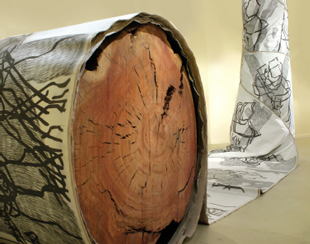Special Exhibition – Daniella Sheinman, String Line
By Howard Rutkowski
 Having studied painting and sculpture at the Belazel Academy of Art and Design in Jerusalem and Tel Aviv’s Avni Institute of Art and Design, Daniella Sheinman’s first works reflected a more conservative approach to figurative works, very much in the European modernist tradition. These were competent works, utilizing a strong sense of color and line, but were not ground-breaking in any sense. That all changed when Sheinman abandoned figurative imagery and undertook the path towards abstraction.
Having studied painting and sculpture at the Belazel Academy of Art and Design in Jerusalem and Tel Aviv’s Avni Institute of Art and Design, Daniella Sheinman’s first works reflected a more conservative approach to figurative works, very much in the European modernist tradition. These were competent works, utilizing a strong sense of color and line, but were not ground-breaking in any sense. That all changed when Sheinman abandoned figurative imagery and undertook the path towards abstraction.
Through abstraction, the narratives – implied or otherwise – inherent with figuration are given over to a focus on materials, surface and form. In many ways it is a reduction, challenging both artist and viewer to go beyond the immediately recognizable and to concentrate on the application of line or color to find the expressed ideas. It is a notoriously difficult approach that, in the wrong hands can easily disappoint , with results that are merely decorative. However, Sheinman’s forays in this direction allowed her control of line and color to come forth, resulting in more powerful imagery and an interplay of line and pattern.
The early abstract pieces are bold and carefully constructed with a very direct visual impact. They are like declarative sentences that communicate without hesitation what the artist was crafting. Over time, these works, too, evolved into more spontaneous, more gestural compositions where the experimentation with different materials becomes more integrated. The use of new materials and support structures allowed the artist to explore new approaches with space and taking a very big risk in abandoning color – often the unifying component to painting – Sheinman was able to bring her work from a traditional, two-dimensional presentation to one that would harness the environment where the work was displayed.
This is most evident in two major installation works undertaken in the late 90s – Interior Space presented at the Bayerische Vereinsbank in Frankfurt in 1996 and Meanings of Life at the Museum Ludwig in Koblenz in 1998. These works form the genesis of Sheinman’s focus on the power of the unadorned black line and the integration of the architectural setting to create a physical experience for the viewer.
The paintings, drawings and installations of the past twenty years are not mere formalist exercises, devoid of the persona of the artist. They are, in fact, attempts by the artist to evoke very personal experiences of the interior and exterior world. An example of this is one of her earliest installation pieces, Venus Rising From The Sea, a work reflecting on the famous Botticelli masterpiece of the 15th century. The imagery was a means for the artist to address inner thoughts and feelings that she experienced at the time and saw as a metaphor for the changes in her own life as well as in her work. The Venus image is one that recurs over time and a series of drawings on the subject were exhibited in the lobby of the then newly-reborn Plaza Hotel in Manhattan in 2008, an appropriate venue for the concept of regeneration.
String Line, first exhibited in Tel Aviv in 2013 (and presented as the signature installation for the 2015 edition of Art Palm Beach), encapsulates Sheinman’s pursuit of the simple black line to create and define rhythm and space. The individual, staccato lines merge together into an undulating pattern, underscored by the expanse of a monochrome background. String Line was inspired by Dave Brubeck’s 1959 Strange Meadowlark, a composition that begins with the piano in no clear time, but comes together in a unified whole with the entrance of the rest of the instruments. Indeed, with String Line the jerky individual lines begin to coalesce as the composition expands and reaches its conclusion.
Two decades ago, affected by a series of world-wide cataclysmic events, Sheinman eschewed color to harness the black line of graphite to emphasize the power of her compositions. Other natural materials formed the support for the subsequent works. String Line takes a step forward with the introduction of Plexiglas, clearly a non-natural material, yet one that allows the stark lines to expand into a limitless space, present, but undefined, not unlike Brubeck’s ground-breaking experimentation with musical forms.
Again, like a jazz composition that is never played the same way twice, String Line takes new forms, dependent upon its physical environment and yet transforming it to create a different experience.
Over the course of a thirty-year career, Sheinman has exhibited extensively in Europe, the United States and, of course, in Israel. The installation of String Line, together with her works on view in the Litvak Gallery booths, offer visitors to Art Palm Beach an opportunity to experience these imaginative and life-affirming works.
 Daniella Sheinman
Daniella Sheinman